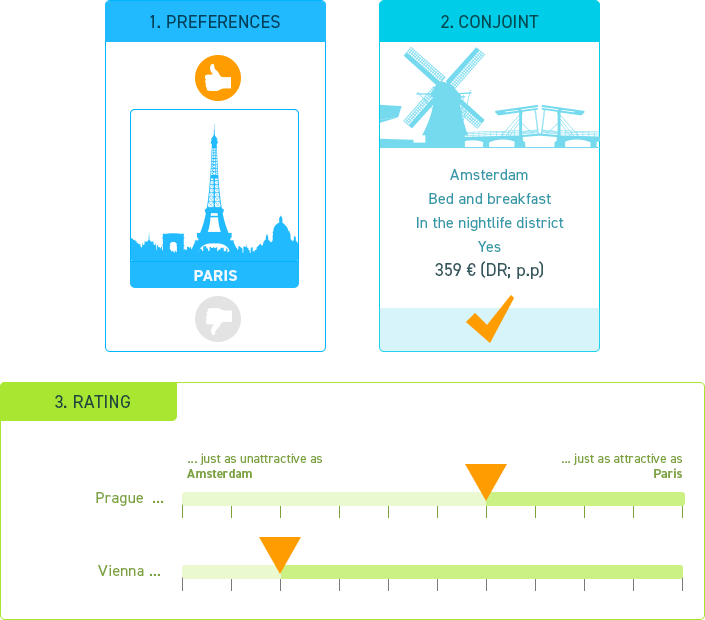HIT-Conjoint
OUR INDIVIDUAL-LEVEL CONJOINT ANALYSIS FOR A MORE PRECISE PREFERENCE EVALUATION
A Hybrid Individualized Two-Level Conjoint (also known as Hybrid Individual-Level Conjoint) is a specialized method of Conjoint Analysis that enables the identification of individual customer preferences at the level of individual features and feature levels. Unlike traditional Conjoint Methods, where all respondents evaluate the same attributes and attribute levels, the Hybrid Individualized Two-Level Conjoint generates individualized attribute combinations based on respondents’ inputs. These individualized attribute combinations allow respondents to evaluate their preferences more precisely and thus achieve higher predictive accuracy. The Hybrid Individualized Two-Level Conjoint is a sophisticated Conjoint Method, but it can provide valuable insights into individual customer preferences.
COMBINATION OF CONVENTIONAL RATING AND CONJOINT METHOD
The basic idea of the Hybrid Individualized Two-level Conjoint is to combine conjoint with conventional ratings. It was originally developed as Hybrid Individualized Two-Level Choice-Based Conjoint (HIT-CBC). But the principle can be applied to all conjoint procedures.
In the actual conjoint part, only two levels are used for each attribute, while the remaining levels are evaluated on a rating scale.
The specific intention of this procedure is to incorporate more extensive sets of levels into a Conjoint Design and to eliminate the so-called NLE problem (Number-of-levels effect). This assumes that the importance of features is influenced by their number of levels (the more levels, the greater the importance).
HIT Conjoint process has three phases
- In the first phase of the survey, the respondents are presented, attribute by attribute, with all the relevant levels of each one. They indicate in each case which level has the highest and which one has the lowest preference.
- This is followed by a Conjoint section which contains only the levels of each attribute with the highest and lowest preference.
- In a third phase, the remaining levels are rated on a scale whose endpoints represent the levels of the respective attributes that were used in the conjoint.

HIT Conjoint
The utility values of all the levels used in the conjoint are calculated or estimated according to the chosen holistic approach. For the levels that lie in the preference range between the extreme points, and that were therefore not included in the conjoint, the utility values are determined by means of linear interpolation based on their ratings.
ADVANTAGES OF THE HIT CONJOINT METHOD
- Elimination of the NLE problem
- Conjoint survey is shorter and thus easier to administer.
- High reliability of utility values due to the small number of levels
WHAT YOU SHOULD CONSIDER WITH THE HIT CONJOINT ANALYSIS
- Dilution of the holistic conjoint approach (focus on individual levels)
- Dependence of utility values on the choice of rating scale
- Possibly longer overall survey length and greater complexity of the survey



